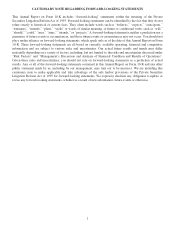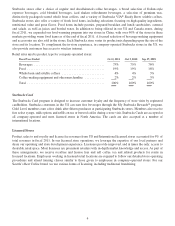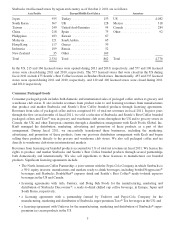Starbucks 2011 Annual Report Download - page 16
Download and view the complete annual report
Please find page 16 of the 2011 Starbucks annual report below. You can navigate through the pages in the report by either clicking on the pages listed below, or by using the keyword search tool below to find specific information within the annual report.• customers trading down to lower priced products within Starbucks, and/or shifting to competitors with
lower priced products;
• lack of customer acceptance of new products or price increases necessary to cover costs of new products
and/or higher input costs;
• unfavorable general economic conditions in the markets in which we operate that adversely affect
consumer spending;
• declines in general consumer demand for specialty coffee products; or
• adverse impacts resulting from negative publicity regarding our business practices or the health effects of
consuming our products;
• cost increases that are either wholly or partially beyond our control, such as:
• commodity costs for commodities that can only be partially hedged, such as fluid milk, and high quality
arabica coffee;
• labor costs such as increased health care costs, general market wage levels and workers’ compensation
insurance costs;
• adverse outcomes of current or future litigation; or
• construction costs associated with new store openings;
• any material interruption in our supply chain beyond our control, such as material interruption of roasted
coffee supply due to the casualty loss of any of our roasting plants or the failures of third-party suppliers, or
interruptions in service by common carriers that ship goods within our distribution channels, or trade
restrictions, such as increased tariffs or quotas, embargoes or customs restrictions;
• delays in store openings for reasons beyond our control, or a lack of desirable real estate locations available
for lease at reasonable rates, either of which could keep us from meeting annual store opening targets and, in
turn, negatively impact net revenues, operating income and earnings per share;
• the degree to which we enter into, maintain, develop, and are able to negotiate appropriate terms and
conditions, and enforce, commercial and other agreements;
• the impact on our business due to labor discord, war, terrorism (including incidents targeting us), political
instability and natural disasters; and
• deterioration in our credit ratings, which could limit the availability of additional financing and increase the
cost of obtaining financing.
•Economic conditions in the US and certain International markets could adversely affect our business and
financial results.
As a retailer that is dependent upon consumer discretionary spending, our results of operations are sensitive to
changes in macro-economic conditions. Our customers may have less money for discretionary purchases as a result
of job losses, foreclosures, bankruptcies, increased fuel and energy costs, higher interest rates, higher taxes, reduced
access to credit and lower home prices. Any resulting decreases in customer traffic and/or average value per
transaction will negatively impact our financial performance as reduced revenues result in sales de-leveraging which
creates downward pressure on margins. There is also a risk that if negative economic conditions persist for a long
period of time or worsen, consumers may make long-lasting changes to their discretionary purchasing behavior,
including less frequent discretionary purchases on a more permanent basis.
10
























